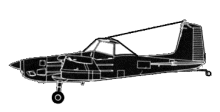
ASN Wikibase Occurrence # 355394
This information is added by users of ASN. Neither ASN nor the Flight Safety Foundation are responsible for the completeness or correctness of this information.
If you feel this information is incomplete or incorrect, you can submit corrected information.
| Date: | Thursday 14 August 1997 |
| Time: | 11:45 LT |
| Type: |  Cessna A188B |
| Owner/operator: | Private |
| Registration: | N731GE |
| MSN: | 18802878T |
| Year of manufacture: | 1977 |
| Total airframe hrs: | 4609 hours |
| Engine model: | Continental IO-520-D |
| Fatalities: | Fatalities: 0 / Occupants: 1 |
| Aircraft damage: | Substantial |
| Category: | Accident |
| Location: | Elwood, NE -
 United States of America United States of America
|
| Phase: | Initial climb |
| Nature: | Agricultural |
| Departure airport: | (2NE0) |
| Investigating agency: | NTSB |
| Confidence Rating: |
The pilot said that before takeoff, he loaded the airplane with 130 gallons of water and chemical, placing the airplane near it's maximum restricted operating gross weight of 4,200 pounds. 'The temperature was about 80 degrees with high humidity from rain the night before.' The wind was light out of the west. 'I started my takeoff roll to the north on the grass runway, rolled 1,000 feet, and brought the tail up.' The pilot said he rolled another 500 feet, lowered five degrees of flaps, and started to lift off of the ground. 'The plane settled back down.' The pilot lowered the flaps to 10 degrees and tried to lift off again, but the airplane would not take off. 'The airplane impacted a bank with brush on it at the end of the runway.' Examination of the wreckage revealed no anomalies. The Cessna A188B Owner's Manual states that for airplanes operated in the restricted category, 'Take-off performance at these gross weights is limited, and ideal field elevation, runway, and weather conditions are expected to exist in obtaining satisfactory take-off performance. Operation from fields in excess of 1,000 above sea level, rough or soft runways, adverse runway gradients, high outside air temperature, turbulence, etc., may prevent a safe take-off at these gross weights. All of these things must be considered by the operator.' The manual also states that, 'The optimum flap setting for take-off at the maximum restricted category gross weight with dispersal equipment installed is 10-degrees.'
Probable Cause: the pilot not maintaining clearance from the bushes. Factors contributing to this accident were the pilot's inadequate preparation prior to the takeoff attempt, his changing flap positions during the takeoff run which degraded the airplane's performance further, and the bushes.
Accident investigation:
 |
|
Sources:
NTSB CHI97LA257
History of this aircraft
Other occurrences involving this aircraft
| 16 July 2005 | N731GE | Gudgel Aero Ag | 0 | Bishop, California |  |
sub |
| 19 June 2009 | N731GE | Thomas Helicopters Inc. | 0 | Ogden, Utah |  |
sub |
| Runway excursion | ||||||
Location
Revision history:
| Date/time | Contributor | Updates |
|---|---|---|
| 12-Mar-2024 11:30 | ASN Update Bot | Added |
Corrections or additions? ... Edit this accident description
The Aviation Safety Network is an exclusive service provided by:


 ©2024 Flight Safety Foundation
©2024 Flight Safety Foundation